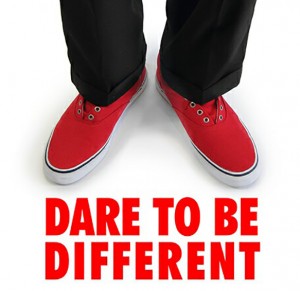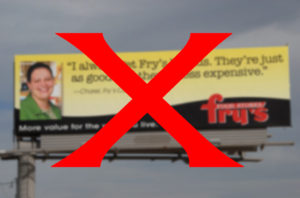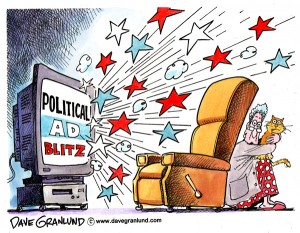Some of you are going to disagree with what I’m about to say. Especially if you think that the secret to successful marketing is having a great social media program … or a brilliantly designed website … or beautiful literature… or just having been around a long time.
The real Silver Bullet to Marketing … well, actually there are two silver bullets:
1 – Defining a clear and unique point of difference from others in your category and
2 – Telling that story in a way that grabs the audience’s attention and captivates their imagination.
In short, it’s not WHERE your message is told but WHAT your message is and HOW compellingly it’s told. It’s all about the message. Period. End of sentence.
We have clients that use Facebook, TV, print, online and email marketing. But without something truly original and compelling to say, none of those mediums would work.
I can’t tell you the number of times we’ve spoken with companies who complain that “radio never works,” or nobody’s reading the newspapers anymore. Then we ask to see what they’ve been running on radio or in the newspapers and, to us, the problem is crystal clear: the message just doesn’t set them apart and it’s not exciting enough to get anyone to pay attention, let alone remember or act on it.
And that’s equally true with Facebook or any other digital marketing. How many Facebook pages are just a jumble of unrelated posts that don’t point to a uniform branded message? How many posts are just … nice … but aren’t really worth clicking the like button, let alone sharing? And how many websites are hardly more than online catalogs without an original point of view that attracts and engages the visitor?
The legendary adman Bill Bernbach said it correctly: “The truth isn’t the truth until people believe you — and they can’t believe you if they don’t know what you’re saying — and they can’t know what you’re saying if they don’t listen to you — and they won’t listen to you if you’re not interesting — and you won’t be interesting unless you say things imaginatively, originally and freshly.”
Was he right? Based on that philosophy, his agency, DDB, built such previously unknown names as VW, Alka Seltzer, Sony and Avis into powerhouse brands – and it even got a president elected.
Over the years, media choices have come and gone. Today, the audience spends more time on Hulu than on NBC, and their mobile phone is their connection to the outside world. But Bernbach’s words remain as potent now as they did when he said them.
If your marketing isn’t pulling for you the way you’d like, don’t look at the medium for the solution. Look at the message. That’s the only true connection between you and the people you want to buy from you.
So, for the record, our mantra is this – and it’s been this since we first opened our doors: The Right Message, Compellingly Told, is Everything! That’s marketing’s Silver Bullet.
####
Dan Katz is president, creative director of LA ads. To discuss your thoughts with Dan on this blog or any marketing matters, email via this link, or visit www.LAadsMarketing.com. You can also connect with Dan on LinkedIn. See agency work via this link.

 There’s a traditional Japanese proverb that says “The nail that stands out is quickly hammered down.” For generations, conformity has been a societal standard in Japan.
There’s a traditional Japanese proverb that says “The nail that stands out is quickly hammered down.” For generations, conformity has been a societal standard in Japan. Living in Los Angeles, you can’t avoid lengthy commutes, and with lengthy commutes comes lots of opportunities to see billboards. Oh, we’ve got lots of ‘em…of all sizes…pitching everything from auto lube centers to Hollywood blockbusters. Yes, even funeral homes and law firms use this tried-and-true medium, which as it turns out, is a great vehicle (no pun intended) for local advertising. After all, done right, billboards can stand out. If you’re stuck in traffic, you’re a captive audience. They’re a great “reminder” medium supporting other marketing efforts. And they can be located strategically, even across the street from a competitor!
Living in Los Angeles, you can’t avoid lengthy commutes, and with lengthy commutes comes lots of opportunities to see billboards. Oh, we’ve got lots of ‘em…of all sizes…pitching everything from auto lube centers to Hollywood blockbusters. Yes, even funeral homes and law firms use this tried-and-true medium, which as it turns out, is a great vehicle (no pun intended) for local advertising. After all, done right, billboards can stand out. If you’re stuck in traffic, you’re a captive audience. They’re a great “reminder” medium supporting other marketing efforts. And they can be located strategically, even across the street from a competitor! Whether you love Donald Trump or you hate him, there’s one thing you’ll have to agree on: He broke every rule of presidential politics…and won! The guy has said things, the guy has done things that every pundit said would lose him the election. And he won!!!
Whether you love Donald Trump or you hate him, there’s one thing you’ll have to agree on: He broke every rule of presidential politics…and won! The guy has said things, the guy has done things that every pundit said would lose him the election. And he won!!! I can remember it like it was yesterday: I and some others from my agency team along with the client’s CMO were sitting in the office of the CEO for a Fortune 100 company presenting the advertising campaign for the year. The CEO looked at us and pointedly said, “Strategy is results!” What he meant was that the strategy doesn’t matter as long as you are producing results. This CEO saw: strategy = analysis and execution = getting things done, and he attributed more value to doing than to analyzing. Strategy statements like “Being the brand of choice in the vertical markets we serve” and similar statements were not for him. And frankly, I’m not a fan of them either.
I can remember it like it was yesterday: I and some others from my agency team along with the client’s CMO were sitting in the office of the CEO for a Fortune 100 company presenting the advertising campaign for the year. The CEO looked at us and pointedly said, “Strategy is results!” What he meant was that the strategy doesn’t matter as long as you are producing results. This CEO saw: strategy = analysis and execution = getting things done, and he attributed more value to doing than to analyzing. Strategy statements like “Being the brand of choice in the vertical markets we serve” and similar statements were not for him. And frankly, I’m not a fan of them either. “Life can only be understood backwards; but it must be lived forwards.” – Soren Kierkegaard
“Life can only be understood backwards; but it must be lived forwards.” – Soren Kierkegaard Whittier, CA – LA ads client Rose Hills Memorial Park has been selected as this year’s winner of the prestigious ACE (American Cemetery Excellence) Award. The award, presented by American Cemetery & Cremation Magazine, one of the leading publications serving the funeral and cemetery industry, recognizes the most outstanding cemeteries both within the United States and abroad.
Whittier, CA – LA ads client Rose Hills Memorial Park has been selected as this year’s winner of the prestigious ACE (American Cemetery Excellence) Award. The award, presented by American Cemetery & Cremation Magazine, one of the leading publications serving the funeral and cemetery industry, recognizes the most outstanding cemeteries both within the United States and abroad. I’m so glad it’s over. Probably like you, my home phone was being called at an increasing rate the closer that we got to Election Day. Candidates’ faces and names were everywhere and on everything from direct mail to lawn signs and outdoor boards to TV and radio commercials. As annoying as it was, there were a number of messaging strategies and tactics that caught my attention because they were executed exceedingly well, which, as marketers, we should consider adding to our communication toolkits for use tomorrow, next week or next month. For as we all know, your customer and prospects are still being bombarded with marketing messages each and every day by both you and your competitors.
I’m so glad it’s over. Probably like you, my home phone was being called at an increasing rate the closer that we got to Election Day. Candidates’ faces and names were everywhere and on everything from direct mail to lawn signs and outdoor boards to TV and radio commercials. As annoying as it was, there were a number of messaging strategies and tactics that caught my attention because they were executed exceedingly well, which, as marketers, we should consider adding to our communication toolkits for use tomorrow, next week or next month. For as we all know, your customer and prospects are still being bombarded with marketing messages each and every day by both you and your competitors. Oh, the wonder of beautifully crafted taglines. Those few strategically selected words that sum up everything your business stands for and what you want your target audience to know about you. They’ve made companies fortunes by telling people what makes them standout in the sea of sameness. Consider FedEx’s brilliant “When it absolutely, positively has to be there overnight.” Nine simple words that tell FedEx buyers precisely what they’re going to get, while simultaneously informing all of its employees what their mission is. What if FedEx’s slogan was “We ship things!”? Would Nike be as successful if it allowed an executive committee to red-pencil “Just do it” into “When you need great shoes”? How would BMW’s vision change if “The Ultimate Driving Machine” became “Our cars are fun to drive!” My point is that these companies didn’t settle for weak platitudes or vague, generalized statements that could have applied to their competitors. Nope, they decided that they weren’t going to settle. Instead standing out and differentiating themselves was business-critical. Can the same be said for your company and its marketing? Do you have a themeline or slogan that makes you stand out? Is it unique and memorable? Or is it mediocre because somewhere down the line, people settled?
Oh, the wonder of beautifully crafted taglines. Those few strategically selected words that sum up everything your business stands for and what you want your target audience to know about you. They’ve made companies fortunes by telling people what makes them standout in the sea of sameness. Consider FedEx’s brilliant “When it absolutely, positively has to be there overnight.” Nine simple words that tell FedEx buyers precisely what they’re going to get, while simultaneously informing all of its employees what their mission is. What if FedEx’s slogan was “We ship things!”? Would Nike be as successful if it allowed an executive committee to red-pencil “Just do it” into “When you need great shoes”? How would BMW’s vision change if “The Ultimate Driving Machine” became “Our cars are fun to drive!” My point is that these companies didn’t settle for weak platitudes or vague, generalized statements that could have applied to their competitors. Nope, they decided that they weren’t going to settle. Instead standing out and differentiating themselves was business-critical. Can the same be said for your company and its marketing? Do you have a themeline or slogan that makes you stand out? Is it unique and memorable? Or is it mediocre because somewhere down the line, people settled? Fulfillment isn’t always what it’s cracked up to be, especially in business. Consider a conversation I had today with one of our media reps that revealed why so many B2B ads aren’t just bland but simply bad. This was in response to why an ad appeared in their publication quite differently from what the advertiser expected. (We didn’t do this ad, so we’re off the hook!) When we asked the rep why the ad didn’t fit the space properly, and why the publication didn’t contact the advertiser to discuss the problem, the answer was they’re so used to getting poorly-designed ads, they’ve just come to accept what they’re sent without question.
Fulfillment isn’t always what it’s cracked up to be, especially in business. Consider a conversation I had today with one of our media reps that revealed why so many B2B ads aren’t just bland but simply bad. This was in response to why an ad appeared in their publication quite differently from what the advertiser expected. (We didn’t do this ad, so we’re off the hook!) When we asked the rep why the ad didn’t fit the space properly, and why the publication didn’t contact the advertiser to discuss the problem, the answer was they’re so used to getting poorly-designed ads, they’ve just come to accept what they’re sent without question.